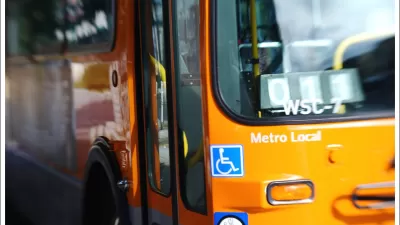Sam Lubell reports on the speculative visions unveiled this week by six teams of international design talent competing to develop a Master Plan for LA's historic Union Station and its surrounding properties.
Lubell describes the "strange state of affairs" surrounding the competition to work with Metro, the regional transportation authority, to develop the Union Station Master Plan, and the recent public unveiling of "vision boards" from the six competing teams which, as was openly noted, have no relevance to the competition, the purview of the future Master Plan, or what could actually get built.
At Wednesday's show and tell, presenters from the multinational teams, such as Ben Van Berkel, of UN Studio, and Renzo Piano, were given five minutes each to describe their speculative visions for how the neighborhood around the station (stretching from downtown to the LA River) might look in the year 2050.
While imaginative and stimulating, as Lubell notes, "The boards, presented in front of a packed house at the station yesterday, will hold no weight in the team selection. That choice will be made, by the end of June, on the much more nuts-and-bolts basis of qualifications, interviews, data collection, draft alternatives and implementation strategies, aka 'scope of work.'"
What then was their purpose? "'It's about fun and inspiration and the future of Los Angeles,' said Martha Welborne, Metro Executive Director, Countywide Planning, of the vision boards. She appears to be fighting an uphill battle to get the bureaucratic and engineering-driven agency to embrace design. 'It's about opening up their imagination before they have to get serious about the limitations,' she noted, of the architect/engineer teams' proposals. 'These are not going to get built.'"
FULL STORY: State of the Union

Alabama: Trump Terminates Settlements for Black Communities Harmed By Raw Sewage
Trump deemed the landmark civil rights agreement “illegal DEI and environmental justice policy.”

Planetizen Federal Action Tracker
A weekly monitor of how Trump’s orders and actions are impacting planners and planning in America.

The 120 Year Old Tiny Home Villages That Sheltered San Francisco’s Earthquake Refugees
More than a century ago, San Francisco mobilized to house thousands of residents displaced by the 1906 earthquake. Could their strategy offer a model for the present?

Ken Jennings Launches Transit Web Series
The Jeopardy champ wants you to ride public transit.

BLM To Rescind Public Lands Rule
The change will downgrade conservation, once again putting federal land at risk for mining and other extractive uses.

Indy Neighborhood Group Builds Temporary Multi-Use Path
Community members, aided in part by funding from the city, repurposed a vehicle lane to create a protected bike and pedestrian path for the summer season.
Urban Design for Planners 1: Software Tools
This six-course series explores essential urban design concepts using open source software and equips planners with the tools they need to participate fully in the urban design process.
Planning for Universal Design
Learn the tools for implementing Universal Design in planning regulations.
Clanton & Associates, Inc.
Jessamine County Fiscal Court
Institute for Housing and Urban Development Studies (IHS)
City of Grandview
Harvard GSD Executive Education
Toledo-Lucas County Plan Commissions
Salt Lake City
NYU Wagner Graduate School of Public Service





























